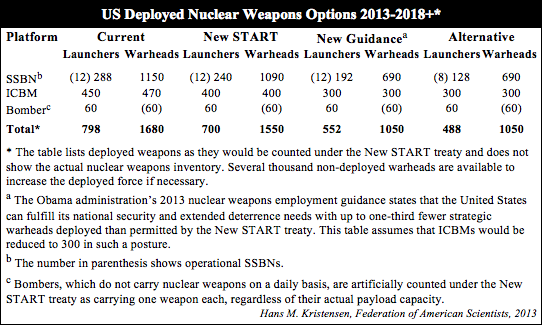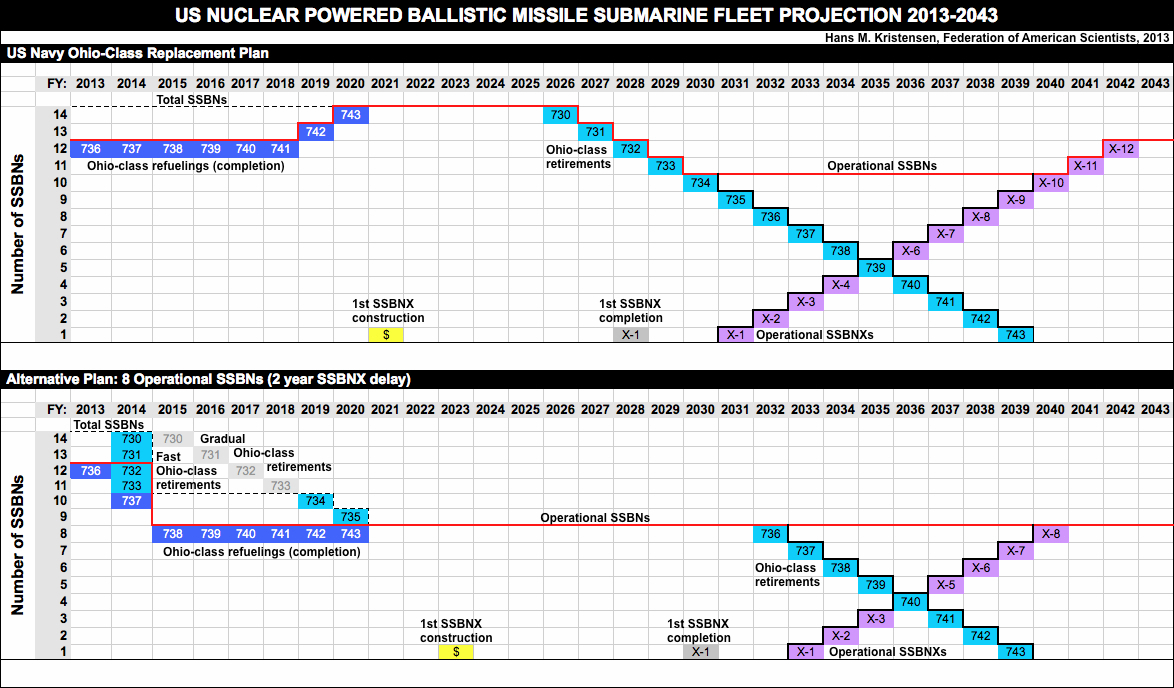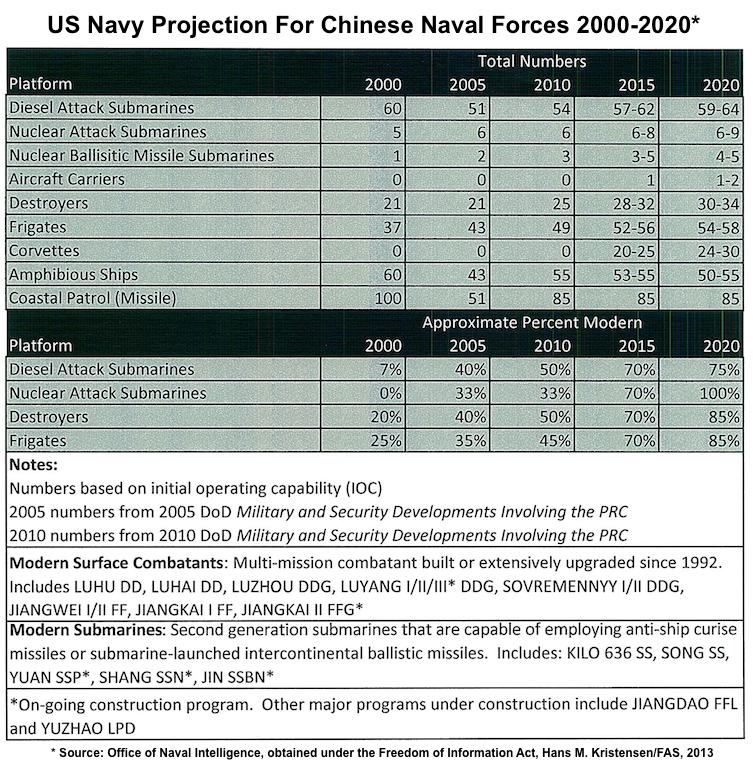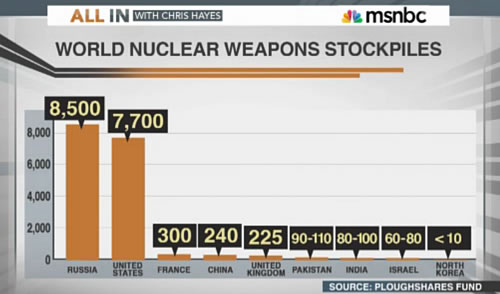B61-12 Nuclear Bomb Integration On NATO Aircraft To Start In 2015
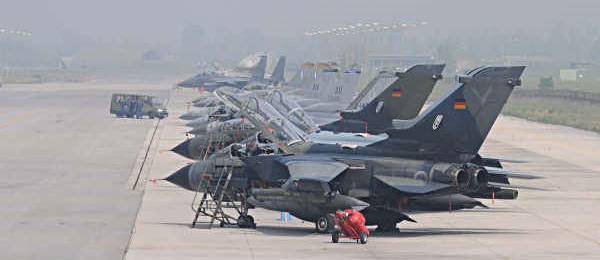
Integration of the new guided B61-12 nuclear bomb will begin in 2015 on NATO Tornado and F-16 aircraft, seen here in 2008 at the Italian nuclear base at Ghedi Torre for the Steadfast Noon nuclear strike exercise. Image: EUCOM.
By Hans M. Kristensen
The US Air Force budget request for Fiscal Year 2015 shows that integration of the B61-12 on NATO F-16 and Tornado aircraft will start in 2015 for completion in 2017 and 2018.
The integration marks the beginning of a significant enhancement of the military capability of NATO’s nuclear posture in Europe and comes only three years after NATO in 2012 said its current nuclear posture meets its security requirements and that it was working to create the conditions for a world without nuclear weapons.
The integration will take place on Belgian, Dutch, and Turkish F-16A/B and on German and Italian PA-200 Tornado fighter-bombers. It is unknown if US and NATO F-16s happen simultaneously or US aircraft are first, but the process will last four years between 2015 and 2018. Integration of German and Italian Tornados will take a little over two years (see graph below).
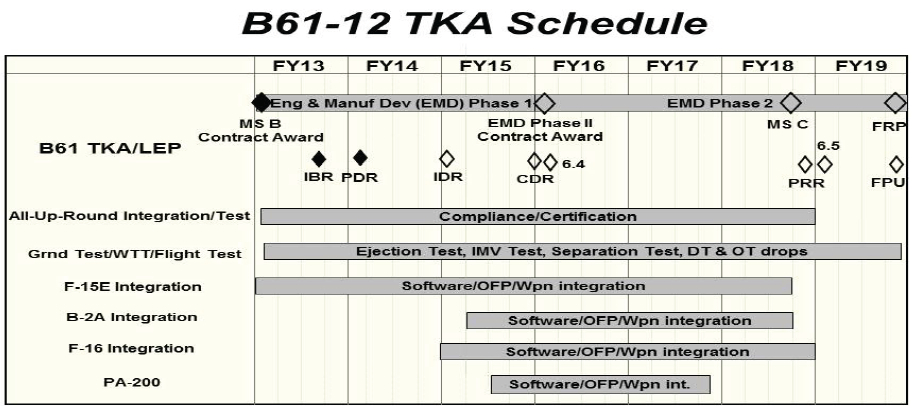
The USAF budget request shows the timelines for integration of the B61-12 onto US and NATO legacy aircraft. Later the weapon will also be integrated onto the F-35A and LRS-B next-generation long-range bomber.
The B61-12 will also be integrated on USAF F-15E (integration began last year), F-16C/D, and B-2A aircraft, and later on the F-35A Lightning II. The F-35A will later replace the F-16s. The US Air Force plans to equip all F-35s in Europe with nuclear capability by 2024.
In addition to the US Air Force, the nuclear-capable F-35A will be supplied to the Dutch, Italian, Turkish, and possibly Belgian air forces.
From the mid-2020s, the B61-12 will also be integrated on the next-generation heavy bomber (LRS-B) planned by the US Air Force.
The integration work includes software upgrades on the legacy aircraft, operational flight tests, and full weapon integration. Development of the guided tail kit is well underway in reparations for operational tests. Seven flight tests are planned for 2015. The nuclear warhead and some non-nuclear components won’t be ready until the end of the decade. The first complete B61-12 is scheduled for 2020.
Through 2019, the integration efforts are scheduled to cost more than $1 billion. Another $154 million is needed to improve security at the nuclear bases in Europe.
Integration of US nuclear weapons onto aircraft of non-nuclear weapon states that have signed the nuclear Non-Proliferation Treaty and promised “not to receive the transfer from any transferor whatsoever of nuclear weapons or other nuclear explosive devices or of control over such weapons or explosive devices directly, or indirectly,” is, to say the least, problematic.
The arrangement of equipping non-nuclear NATO allies with the capability and role to deliver US nuclear weapons was in place before the NPT entered into effect and was accepted by the NPT regime during the Cold War. But for NATO to continue this arrangement contradicts the non-proliferation standards that the member countries are trying to promote in the post-Cold War world.
How scattering enhanced nuclear bombs across Europe in five non-nuclear countries will enable “bold reductions” in US and Russian non-strategic nuclear weapons in Europe and help create the conditions for a world without nuclear weapons is another question.
This publication was made possible by a grant from the Ploughshares Fund. The statements made and views expressed are solely the responsibility of the author.
NATO Nuclear Weapons Security Costs Expected to Double
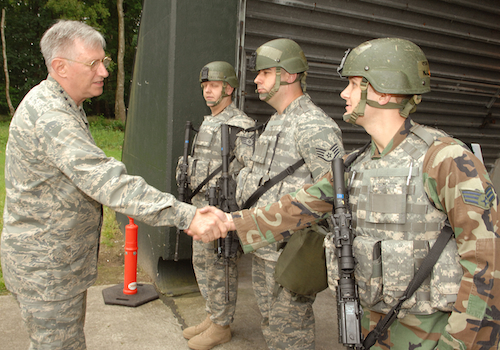
Former US Air Force Europe commander General Rodger Brady shakes hands with 703 Munitions Support Squadron personnel at Volkel Air Base in June 2008 during security upgrades to U.S. nuclear weapons storage sites in Europe. More expensive security upgrades are planned.
By Hans M. Kristensen
The cost of securing U.S. non-strategic nuclear weapons deployed in Europe is expected to nearly double to meet increased U.S. security standards, according to the Pentagon’s FY2015 budget request.
According to the Department of Defense NATO Security Investment Program , NATO has invested over $80 Million since 2000 to secure nuclear weapons storage sites in Belgium, Germany, Italy, the Netherlands, and Turkey.
But according to the Department of Defense budget request, new U.S. security standards will require another $154 million to further beef up security at six bases in the five countries.
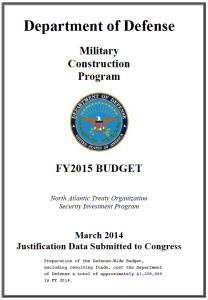
DOD budget document says more expensive security upgrades are needed for nuclear bases in Europe.
After a US Air Force Blue Ribbon Review in 2008 discovered that “most” U.S. nuclear weapons sites in Europe did not meet U.S. security requirements, the Dutch government denied there were security problems.
Yet more than $63 million of the over $80 million spent on improving security since 2000 were spent in 2011-2012 – apparently in response to the Blue Ribbon Review findings and other issues.
The additional $154 million suggests that the upgrades in 2011-2012 did not fix all the security issues at the European nuclear bases.
The budget document – which also comes close to officially confirming the deployment of nuclear weapons in Belgium, Germany, Italy, the Netherlands, and Turkey – states:
NATO funds infrastructure required to store special weapons within secure sites and facilities. Since 2000, NATO has invested over $80 million in infrastructure improvements in storage sites in Belgium, Germany, Italy, the Netherlands, and Turkey. Another $154 million will be invested in these sites for security improvements to meet with stringent new U.S. standards.
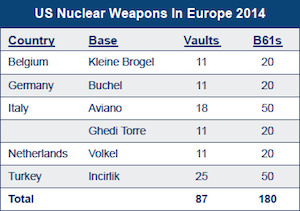
The US Air Force still deploys about 180 nuclear B61 bombs at six bases in five European countries. Despite tight security, the bases are not secure enough.
In addition to the growing security costs, the United States spends approximately $100 million per year to deploy 184 nuclear B61 bombs in the five NATO countries. And it plans to spend an additional $10 billion on modernizing the B61 bombs and hundreds of millions on integrating the weapons on the new F-35A Lightning fighter-bomber.
No doubt the United States and NATO have more urgent defense needs to spend that money on than non-strategic nuclear weapons.
Additional background: Briefing on B61 bomb and deployment in Europe
This publication was made possible by a grant from the Ploughshares Fund. The statements made and views expressed are solely the responsibility of the author.
B61-12: First Pictures Show New Military Capability
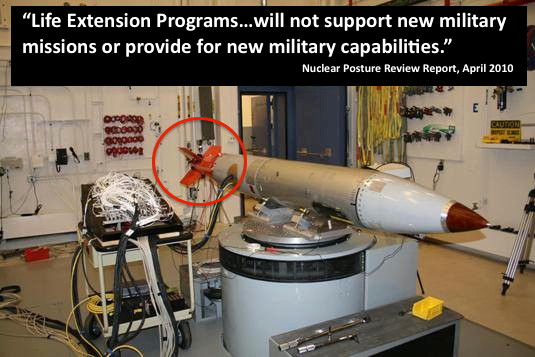
The guided tail kit of the B61-12 will create the first U.S. guided nuclear bomb.
Image: National Nuclear Security Administration. Annotations added by FAS.
By Hans M. Kristensen
The U.S. government has published the first images of the Air Force’s new B61-12 nuclear bomb. The images for the first time show the new guided tail kit that will provide new military capabilities in violation of the Nuclear Posture Review.
The tail kit will increase the accuracy of the bomb and enable it to be used against targets that today require bombs with higher yields.
The guided tail kit is also capable of supporting new military missions and will, according to the former USAF Chief of Staff, affect the way strike planners think about how to use the weapon in a war.
The new guided weapon will be deployed to Europe, replacing nearly 200 non-guided nuclear B61 bombs currently deployed in Belgium, Germany, Italy, the Netherlands, and Turkey.
Military Characteristics
The images show significant changes to the rear end of the bomb where the tail wing section has been completely replaced and the internal parachute removed. The length of the B61-12 appears to be very similar to the existing B61 (except B61-11 which is longer) although possibly a little bit shorter (see below).
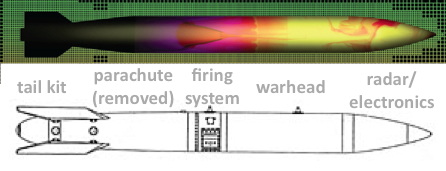
The guided tail kit on the B61-12 (top) is replacing the fixed tail section on the existing B61 (bottom) and the parachute inside.
Source: Los Alamos National Laboratory/U.S. Air Force. Annotations added by FAS.
The new guided tail kit will not use GPS (global positioning system) but is thought to use an Internal Guidance System (INS). The precise accuracy is not known, but conventional bombs using INS can achieve an accuracy of 30 meters or less. Even if it were a little less for the B61-12, it is still a significant improvement of the 110-180 meters accuracy that nuclear gravity bombs normally achieve in test drops.
The tail kit will also provide the B61 with a “modest standoff capability” by enabling it to glide toward its target, another military capability the B61 doesn’t have today.
Inside the bomb, non-nuclear components will be refurbished or replaced. In the nuclear explosives package the B61-4 primary (pit) will be reused and the secondary remanufactured. Detonators will be replaced with a design used in the W88 warhead, conventional Insensitive High Explosives will be remanufactured, and a new Gas Transfer System will be installed to increase the performance margin of the primary.
The B61-4 warhead used in the B61-12 has four selectable yields of 0.3, 5, 10, and 50 kilotons. LEPs are not allowed to increase the yield of warheads but GAO disclosed in 2011 that STRATCOM “expressed a requirement for a different yield [and that] U.S. European Command and SHAPE [Supreme Headquarters Allied Powers Europe] agreed to the proposal.” It is unknown if the different yield is a modification of one of the three lower yield options or an increase of the maximum yield. During another upgrade of the B61-7 bomb to the B61-11 earth-penetrator, the yield was increased from 360 kilotons to 400 kilotons.
Although increasing safety and security were prominent justifications for securing Congressional funding for the B61-12, enhancements to the safety and security of the new bomb are apparently modest. More exotic technologies such as multi-point safety and optical detonators were rejected.
The complex upgrades add up to the most expensive U.S. nuclear bomb project ever – currently estimated at approximately $10 billion for 400-500 bombs.
Political Implications
Enhancing military capabilities of nuclear weapons (accuracy and yield) is controversial and Government officials in the United States and European capitals are trying to dodge the issue. The 2010 Nuclear Posture Review Report explicitly promised that “Life Extension Programs…will not support new military missions or provide for new military capability capabilities.” But the guided tail kit is a new military capability and so is a different explosive yield.
Military and government officials will privately admit to the change but the public line is that this is a simple life-extension of the existing B61 with no new military capabilities.
During a recent visit to Europe where I briefed the Dutch and Belgian parliaments on the status and implications of the B61 modernization, parliamentarians were concerned that this kind of clandestine nuclear modernization under the guise of life-extension is unacceptable at the national level and counterproductive at the international level. They said they had not been informed about the upcoming deployment of improved nuclear capabilities in their countries. Their governments’ position is that there is no improvement and therefore no need to inform anyone. But one Dutch government official told me in so many words that they haven’t actually checked but trust the United States would not introduce improved nuclear bombs in Europe without telling the allies. A Dutch parliamentarian said he knew for sure that the improved capability is known within the ministry of defense.
The parliamentarians were also concerned that improving the military capabilities sends the wrong message about NATO’s nuclear policy, in particular its promise to reduce nuclear weapons in Europe and seeking to create the conditions for a world without nuclear weapons. Deploying a new guided nuclear bomb on a new stealthy F-35 fighter-bomber in Europe will make it hard for NATO to argue that Russia should reduce and not improve its non-strategic nuclear posture.
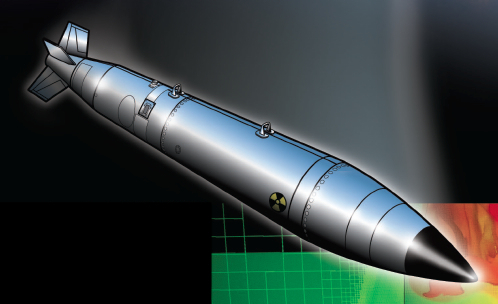
The B61-12 will have a new military capability to glide toward its target.
Image: Los Alamos National Laboratory
Many NATO countries quietly favor a withdrawal of the U.S. nuclear weapons from Europe but feel hamstrung by NATO policy, which mistakenly confuses generic security concerns of some eastern European allies with a need for nuclear weapons in Europe. The security concerns obviously must be addressed but not with fake assurance by tactical nuclear bombs that are the least likely to ever be used in response to the kinds of security challenges that face Europe today.
NATO decided in 2012 “that the Alliance’s nuclear force posture currently meets the criteria for an effective deterrence and defense posture.” If so, why enhance it with guided B61-12 nuclear bombs and F-35 stealth fighter-bombers?
Additional information: previous articles about the B61-12
This publication was made possible by a grant from the Ploughshares Fund. The statements made and views expressed are solely the responsibility of the author.
A Credible Radioactive Threat to the Sochi Olympics?
With the Sochi Olympics set to start on February 6th there has been an escalating concern about security threats to the Games. There are hunts for female suicide bombers (“black widows”), video threats from militant groups, etc., all of which have triggered a massive Russian security response, including statements by President Putin insuring the safety of the Games.
Many of the security concerns are raised by the proximity of Sochi to Chechnya and relate to the threats expressed by Chechen leader Doku Umarov who exhorted Islamic militants to disrupt the Olympics.
In the past weeks the region has seen Islamic militants claims that they carried out two recent suicide bombings in Volgorad which tragically killed 34 people and injured scores of others. Volgograd is about 425 miles from Sochi and although the media stresses the proximity it is a considerable distance.
General Confirms Enhanced Targeting Capabilities of B61-12 Nuclear Bomb

By Hans M. Kristensen
The former U.S. Air Force Chief of Staff, General Norton Schwartz, confirmed last week that the B61-12 nuclear bomb planned by the Obama administration will have improved military capabilities to attack targets with greater accuracy and less radioactive fallout.
The confirmation comes two and a half years after an FAS publication first described the increased accuracy of the B61-12 and its implications for nuclear targeting in general and the deployment of U.S. nuclear weapons in Europe in particular.
The confirmation is important because the 2010 Nuclear Posture Review (NPR) pledged that nuclear warhead “Life Extension Programs…will not support new military missions or provide for new military capabilities.”
In addition to violating the NPR pledge, enhancing the nuclear capability contradicts U.S. and NATO goals of reducing the role of nuclear weapons and could undermine efforts to persuade Russia to reduce its non-strategic nuclear weapons posture.
Confirmation of the enhanced military capability of the B61-12 also complicates the political situation of the NATO allies (Belgium, Germany, Italy, the Netherlands, and Turkey) that currently host U.S. nuclear weapons because the governments will have to explain to their parliaments and public why they would agree to increase the military capability.
Desired Military Capability
General Schwartz’s confirmation came during a conference organized by the Stimson Center in response to a question from Steven Young (video time 49:15) whether the relatively low yield and increased accuracy of the B61-12 in terms of targeting planning would change the way the military thinks about how to use the weapon.
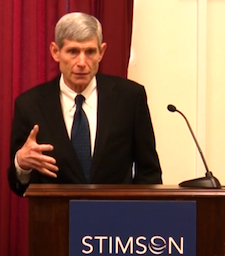
General Schwartz made his statements during a Stimson conference last Thursday.
General Schwartz’s answer was both clear and blunt: “Without a doubt. Improved accuracy and lower yield is a desired military capability. Without a question.”
When asked whether that would result in a different target set or just make the existing weapon better, General Schwartz said: “It would have both effects.”
General Schwartz said that the B61 tail kit “has benefits from an employment standpoint that many consider stabilizing.” I later asked him what he meant by that and his reply was that critics (myself included) claim that the increased accuracy and lower yield options could make the B61-12 more attractive to use because of reduced collateral damage and radioactive fallout. But he said he believed that the opposite would be the case; that the enhanced capabilities would enhance deterrence and make use less likely because adversaries would be more convinced that the United States is willing to use nuclear weapons if necessary.
Military Implications
“Nuclear capable aircraft may have many advantages. Accuracy (as compared to other systems) is not one of them,” the Joint Staff argued in 2004 during drafting of the Doctrine for joint Nuclear Operations. Test drops of U.S. nuclear bombs normally achieve an accuracy of 110-170 meters, which is insufficient to hold underground targets at risk except with very large yield. The designated nuclear earth-penetrator (B61-11) has a 400-kiloton warhead to be effective. Therefore, increasing the accuracy of the B61 to enhance targeting and reduce collateral damage are, as General Schwartz put it at the conference, desired military capabilities.
Increasing the accuracy broadens the type of targets that the B61 can be used to attack. The effect is most profound against underground targets that require ground burst and cratering to be damaged by the chock wave. Against a relatively small, heavy, well-designed, underground structure, severe damage is achieved when the target is within 1.25 the radius of the visible crater created by the nuclear detonation. Light damage is achieved at 2.5 radii. For a yield of 50 kt – the estimated maximum yield of the B61-12, the apparent crater radii vary from 30 meters (hard dry rock) to 68 meters (wet soil). Therefore an improvement in accuracy from 100-plus meter CEP (the current estimated accuracy of the B61) down to 30-plus meter CEP (assuming INS guidance for the B61-12) improves the kill probability against these targets significantly by achieving a greater likelihood of cratering the target during a bombing run. Put simply, the increased accuracy essentially puts the CEP inside the crater (see illustration below).
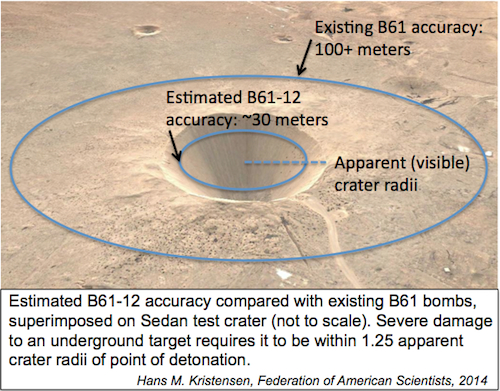
Cratering targets is dirty business because a nuclear detonation on or near the surface kicks up large amounts of radioactive material. With poor accuracy, strike planners would have to choose a relatively high selectable yield to have sufficient confidence that the target would be damaged. The higher the yield, the greater the radioactive fallout.
With the increased accuracy of the B61-12 the strike planners will be able to select a lower yield and still achieve the same (or even better) damage to the underground target. Using lower yields will significantly reduce collateral damage by reducing the radioactive fallout that civilians would be exposed to after an attack. The difference in fallout from a 360-kiloton B61-7 surface burst compared with a B61-12 using a 10-kiloton selective yield option is significant (see map below).
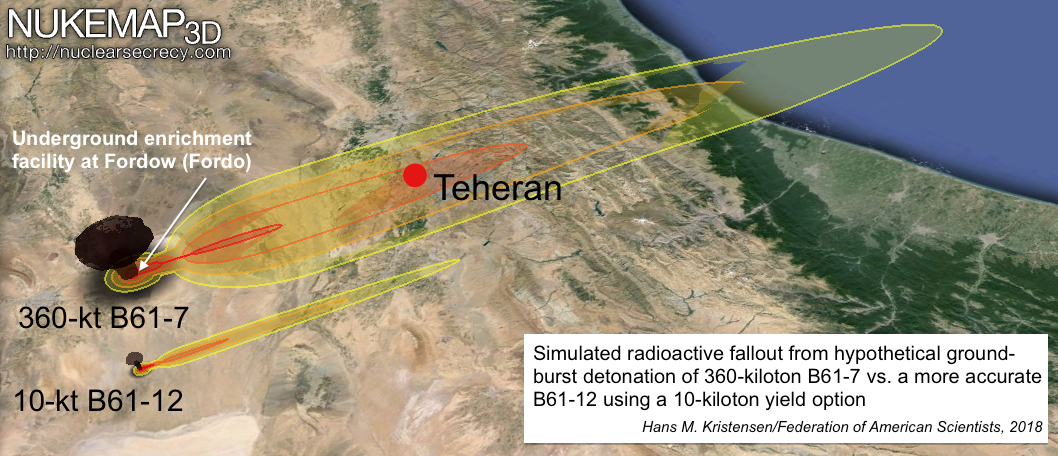
Illustrative difference in radioactive fallout from a 360-kiloton B61-7 surface burst against Iranian underground enrichment facility at Fordow, compared with using a lower-yield option of the B61-12. Fallout calculation from NUKEMAP at nuclearsecrecy.com. Click image to see larger version.
No U.S. president would find it easy to authorize use of nuclear weapon. Apart from the implications of ending nearly 70 years of non-use of nuclear weapons and the international political ramifications, anticipated collateral damage serves as an important constraint on potential use of nuclear weapons. Some analysts have argued that higher yield nuclear weapons are less suitable to deter regional adversaries and that lower yield weapons are needed in today’s security environment. The collateral damage from high-yield weapons could “self-deter” a U.S. president from authorizing an attack.
There is to my knowledge no evidence that potential adversaries are counting on being able to get away with using nuclear weapons because the United States is self-deterred. Moreover, all gravity bombs and cruise missiles currently in the U.S. nuclear arsenal have low-yield options. But poor accuracy and collateral damage have limited their potential use to military planners in some scenarios. The improved accuracy of the B61-12 appears at least partly intended to close that gap.
Implications for NATO
For NATO, the improved accuracy has particularly important implications because the B61-12 is a more effective weapon that the B61-3 and B61-4 currently deployed in Europe.
The United States has never before deployed guided nuclear bombs in Europe but with the increased accuracy of the B61-12 and combined with the future deployment of the F-35A Lightning II stealth fighter-bomber to Europe, it is clear that NATO is up for quite a nuclear facelift.
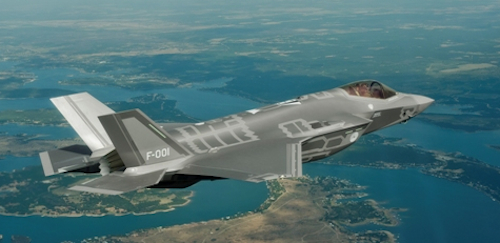
Once European allies acquire the F-35A Lightning II it will “unlock” the guided tail kit on the B61-12 bomb. The increased military capability of the guided B61-12 and stealthy F-35A will significantly enhance NATO’s nuclear posture in Europe.
Initially the old NATO F-16A/B and Tornado PA-200 aircraft that currently serve in the nuclear strike mission will not be able to make use of the increased accuracy of the B61-12, according to U.S. Air Force officials. The reason is that the aircraft computers are not capable of “talking to” the new digital bomb. As a result, the guided tail kit on the B61-12 for Belgian, Dutch, German, Italian and Turkish F-16s and Tornados will initially be “locked” as a “dumb” bomb. Once these countries transition to the F-35 aircraft, however, the enhanced targeting capability will become operational also in these countries.
The Dutch parliament recently approved purchase of the F-35 to replace the F-16, but a resolution adopted by the lower house stated that the F-35 could not have a capability to deliver nuclear weapons. The Dutch government recently rejected the decision saying the Netherlands cannot unilaterally withdraw from the NATO nuclear strike mission.
It is one thing to extend the existing nuclear capabilities in Europe; improving the capabilities, however, appears to go beyond the 2012 Deterrence and Defense Posture Review, which decided that “the Alliance’s nuclear posture currently meets the criteria for an effective deterrence and defense posture.” It is unclear how improving the nuclear posture in Europe will help create the conditions for a world free of nuclear weapons.
It is also unclear how improving the nuclear posture in Europe fits with NATO’s arms control goal to seek reductions in Russian non-strategic nuclear weapons in Europe. Instead, the increased military capabilities provided by the B61-12 and F-35 would appear to signal to Russia that it is acceptable for it to enhance its non-strategic nuclear posture in Europe as well.
Such considerations ought to be well behind us more than two decades after the end of the Cold War but continue to tie down posture planning and political signaling.
See also: B61 LEP: Increasing NATO Nuclear Capability and Precision Low-Yield Nuclear Strikes
This publication was made possible by grants from the New-Land Foundation and Ploughshares Fund. The statements made and views expressed are solely the responsibility of the author.
Making the Cut: Reducing the SSBN Force
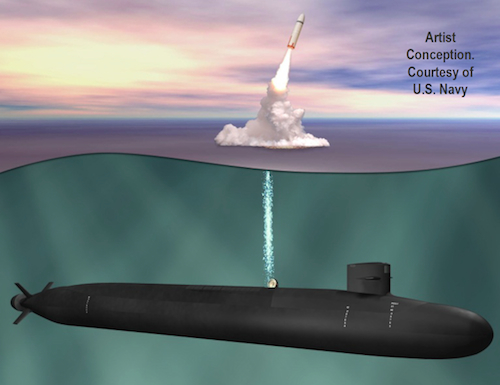
The Navy plans to buy 12 SSBNs, more than it needs or can afford.
By Hans M. Kristensen
A new Congressional Budget Office (CBO) report – Options For Reducing the Deficit: 2014-2023 – proposes reducing the Navy’s fleet of Ohio-class ballistic missile submarines from the 14 boats today to 8 in 2020. That would save $11 billion in 2015-2023, and another $30 billion during the 2030s from buying four fewer Ohio replacement submarines.
The Navy has already drawn its line in the sand, insisting that the current force level of 14 SSBNs is needed until 2026 and that the next-generation SSBN class must include 12 boats.
But the Navy can’t afford that, nor can the United States, and the Obama administration’s new nuclear weapons employment guidance – issued with STRATCOM’s blessing – indicates that the United States could, in fact, reduce the SSBN fleet to eight boats. Here is how.
New START Treaty Force Level
Under the New START treaty the United States plans to deploy 640 ballistic missiles loaded with 1490 warheads (1,550 warheads minus the 60 weapons artificially attributed to bombers that don’t carry nuclear weapons on a daily basis). Of that, the SSBN fleet will account for 240 missiles and 1090 warheads (see table below).
The analysis for the new guidance – formally known as Presidential Policy Decision 24 – determined that the United State could safely reduce its deployed nuclear weapons by up to one-third below the New START level. But even though the current posture therefore is bloated and significantly in excess of what’s needed to ensure the security of the United States and its allies and partners, the military plans to retain the New START force structure until Russia agrees to the reductions in a new treaty.
Yet Russia is already well below the New START treaty force level (-227 launchers and -150 warheads); the United States currently deploys 336 launchers more than Russia (!). Moreover, the Russian missile force is expected to decline even further from 428 to around 400 missiles by the early 2020s – even without a new treaty. Unlike U.S. missiles, however, the Russian missiles don’t have extra warhead spaces; they’re loaded to capacity to keep some degree of treaty parity with the United States.
Making The Cut
The table above includes two future force structure options: a New Guidance option based on the “up to one-third” cut in deployed strategic forces recommended by the Obama administration’s new nuclear weapons employment guidance; and an “Alternative” posture reduced to eight SSBNs as proposed by CBO.
Under the New Guidance posture, the SSBN fleet would carry 690 warheads, a reduction of 400 warheads below what’s planned under the New START treaty. The 192 SLBMs (assuming 16 per next-generation SSBN) would have nearly 850 extra warhead spaces (upload capacity), more than enough to increase the deployed warhead level back to today’s posture if necessary, and more than enough to hedge against a hypothetical failure of the entire ICBM force. In fact, the New Guidance posture would enable the SSBN force to carry almost all the warheads allowed under the New START treaty.
Under the Alternative posture, the SSBN fleet would also carry 690 warheads but there would be 64 fewer SLBMs. Those SLBMs would have “only” 334 extra warhead spaces, but still enough to hedge against a hypothetical failure of the ICBM force. In fact, the SLBMs would have enough capacity to carry almost the entire deployed warhead level recommended by the new employment guidance.
The Navy’s SSBN force structure plan will begin retiring the Ohio-class SSBNs in 2026 at a rate of one per year until the last boat is retired in 2039. The first next-generation ballistic missile submarine (currently known as SSBNX) is scheduled to begin construction in 2021, be completed in 2028, and sail on its first deterrent patrol in 2031. Additional SSBNXs will be added at a rate of one boat per year until the fleet reaches 12 by 2042 (see figure below).
The Navy’s schedule creates three fluctuations in the SSBN fleet. The first occurs in 2019-2020 where the number of operational SSBNs will increase from 12 to 14 as a result of the two newest boats (USS Wyoming (SSBN-742) and USS Louisiana (SSBN-743)) completing their mid-life reactor refueling overhauls. That is in excess of national security needs so at that time the Navy will probably retire the two oldest boats (USS Henry M. Jackson (SSBN-730) and USS Alabama (SSBN-731)) eight years early to keep the fleet at 12 operational SSBNs (this doesn’t show in the Navy’s plan).
The second fluctuation in the Navy’s schedule occurs in 2027-2030 when the number of operational SSBNs will drop to 10 as a result of the retirement of the first four Ohio-class SSBNs and the decision in 2012 to delay the first SSBNX by two years. As it turns out, that doesn’t matter because no more than 10 SSBNs are normally deployed anyway.
The third fluctuation in the Navy’s schedule occurs in 2041-2042 when the number of operational SSBNXs increases from 10 to 12 as the last two boats join the fleet. This is an odd development because there obviously is no reason to increase the fleet to 12 SSBNXs in the 2040s if the Navy has been doing just fine with 10 boats in the 2030s. This also suggests that the fleet could in fact be reduced to 12 boats today of which 10 would be operational. To do that the Navy could retire two SSBNs immediately and two more in 2019-2020 when the last refueling overhauls have are completed.
To reduce the SSBN fleet to eight boats as proposed by CBO, the Navy would retire the six oldest Ohio-class SSBNs at a rate of one per year in 2015-2020. At that point the last Ohio-class reactor refueling will have been completed, making all remaining SSBNs operationally available. A quicker schedule would be to retire four SSBNs in 2014 and the next two in 2019-2020. That would bring the fleet to eight operational boats immediately instead of over seven years and allow procurement of the first SSBNX to be delayed another two years (see figure above).
Reducing to eight SSBNs would obviously necessitate changes in the operations of the SSBN force. The Navy’s 12 operational SSBNs conduct 28 deterrent patrols per year, or an average of 2.3 patrols per submarine. The annual number of patrols has decline significantly over the past decade, indicating that the Navy is operating more SSBNs than it needs. Each patrol lasts on average 70 days and occasionally over 100 days. To retain the current patrol level with only eight SSBNs, each boat would have to conduct 3.5 patrols per year. Between 1988 and 2005, each SSBN did conduct that many patrols per year, so it is technically possible.
Moreover, of the 10 or so SSBNs that are at sea at any given time, about half (4-5) are thought to be on “hard alert” in pre-designated patrol areas, within required range of their targets, and ready to launch their missiles 15 minutes after receiving a launch order. A fleet of eight operational SSBNs could probably maintain six boats at sea at any given time, of which perhaps 3-4 boats could be on alert.
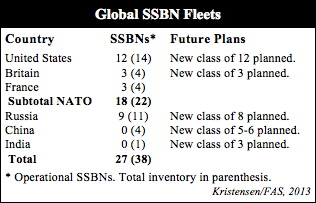 Finally, reducing the SSBN fleet to eight boats seems reasonable because no other country currently plans to operate more than eight SSBNs (see table). The United States today operates more SSBNs than any other country. And NATO’s three nuclear weapon states currently operate a total of 22 SSBNs, twice as many as Russia. China and India are also building SSBNs but they’re far less capable and not yet operational.
Finally, reducing the SSBN fleet to eight boats seems reasonable because no other country currently plans to operate more than eight SSBNs (see table). The United States today operates more SSBNs than any other country. And NATO’s three nuclear weapon states currently operate a total of 22 SSBNs, twice as many as Russia. China and India are also building SSBNs but they’re far less capable and not yet operational.
Conclusions and Recommendations
The Navy could and should reduce its SSBN fleet from 14 to eight boats as proposed by CBO. Doing so would shed excess capacity, help prepare the nuclear force level recommended by the new nuclear weapons employment policy, better match the force levels of other countries, and save billions of dollars. There are several reasons why this is possible:
First, the decision to go to 10 operational SSBNs in the 2030s suggests that the Navy is currently operating too many SSBNs and could immediately retire the two oldest Ohio-class SSBNs.
Second, the decision to build a new SSBN fleet with 144 fewer SLBM launch tubes than the current SSBN fleet is a blatant admission that the current force is significantly in excess of national security needs.
Third, the acknowledgement in November 2011 by former STRATCOM commander Gen. Robert Kehler that the reduction of 144 missile tubes “did not assume any specific changes to targeting or employment guidance” suggests there’s a significant over-capacity in the current SSBN fleet.
Fourth, it is highly unlikely that presidential nuclear guidance three decades from now – when the planned 12-boat SSBNX fleet becomes operational – will not have further reduced the nuclear arsenal and operational requirement significantly.
Fifth, reducing the SSBN fleet now would allow significant additional cost savings: $11 billion in 2015-2023 (and $30 billion more in the 2030s) from reduced ship building according to CBO; completing the W76-1 production earlier with 500 fewer warheads; $7 billion from reducing production of the life-extended Trident missile (D5LE) by 112 missiles; operational savings from retiring six Ohio-class SSBNs early; and by reducing the warhead production capacity requirement for the expensive Uranium Production Facility and Chemistry and Metallurgy Research facilities.
Sixth, reducing the SSBN fleet would help reduce the growing disparity between U.S. and Russian strategic missiles. This destabilizing trend keeps Russia in a worst-case planning mindset suspicious of U.S. intensions, drives large warhead loadings on each Russian missile, and wastes billions of dollars and rubles on maintaining larger-than-needed strategic nuclear force postures.
Change is always hard, but a reduction of the SSBN fleet would be a win for all.
This publication was made possible by grants from the New-Land Foundation and Ploughshares Fund. The statements made and views expressed are solely the responsibility of the author.
New Nuclear Notebook: Chinese Nuclear Force Modernization
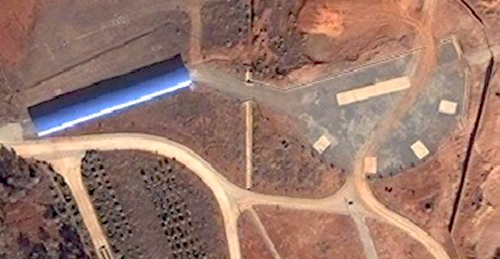
Launch pads for DF-21 mobile medium-range ballistic missile launchers have been added to a Second Artillery base in southern China.
Click image for large version with annotations.
Image: Digital Globe 2012 via Apple Maps.
By Hans M. Kristensen
China continues to upgrade bases for mobile nuclear medium-range ballistic missiles. The image above shows one of several new launch pads for DF-21 missile launchers constructed at a base near Jianshui in southern China.
A new satellite image* on Apple Maps shows the latest part of a two-decade long slow replacement of old liquid-fuel moveable DF-3A intermediate-range ballistic missiles with new road-mobile solid-fuel DF-21 medium-range ballistic missiles.
Similar developments can be seen near Qingyang in the Anhui province in eastern China and in the Qinghai and Xinjiang provinces in central China.
This and other developments are part of our latest Nuclear Notebook on Chinese nuclear forces, recently published by the Bulletin of the Atomic Scientists.
New Nuclear Notebook
In the Nuclear Notebook, Robert Norris and I estimate that China currently has roughly 250 warheads in its nuclear stockpile for delivery by land- and sea-based ballistic missiles, aircraft, and possibly cruise missiles.
This is a slight increase compared with previous years that reflects the introduction of new intercontinental ballistic missiles (ICBMs) and submarine-launched ballistic missiles (SLBMs). China is the only nuclear weapon state party to the Non-Proliferation Treaty that is increasing its nuclear stockpile, which might grow a bit more over as more missiles are fielded over the next decade.
Even so, the Chinese nuclear modernization is very slow, as in the case of the introduction of DF-21 medium-range ballistic missiles (MRBMs) at Jianshui and the apparent (temporary?) leveling out of ICBM deployments; China is clearly not in a hurry to reach parity with the United States or Russia anytime soon (if at all) but instead seems focused on safeguarding its minimum retaliatory nuclear deterrent. Even so, the breadth of Chinese nuclear capabilities is widening with introduction of a class of ballistic missile submarines and cruise missiles that might have nuclear capability. With these come new scenarios and command and controls issues that are not yet apparent or understood.
Several interesting publications have made contributions to the public debate on China’s nuclear force operations and modernization over the past few years. Most valuable has been the work by Mark Stokes at Project 2049, most noticeably his 2010 report on China’s nuclear warhead storage and handling system. Also in 2010, M. Taylor Fravel and Evan Medeiros provided valuable analysis of China’s search for assured retaliation. Retired Russian general Victor Yesin claimed in 2012 that China has 1,300-1,500 nuclear warheads more than assumed by the U.S. intelligence community – a Georgetown University study even imagined 3,000 warheads (we consider these estimates exaggerated; see here and here). And renowned scholars John Lewis and Xue Litai described last year what they view as an increasing complexity of Chinese nuclear war planning.
The SSBN Force
Since our previous Notebook in 2011, most attention has been on the status of China’s new ballistic missile submarines (SSBN) and Julang-2 SLBM. After a series of technical difficulties, the DOD reported in May 2013 that the JL-2 “appears ready to reach initial operational capability in 2013.”
The range of the JL-2 has been the subject of much speculation, and we are struck by how much the range estimates vary and how much experts and news media continued to use outdated estimates or claim that the missile will be able to target the entire United States from Chinese waters. A review of the various estimates published by U.S. government agencies since 1999 shows estimates spanning from 7,000 km to as much as 12,000 km (see image below), although most hover around 7,200+ km.
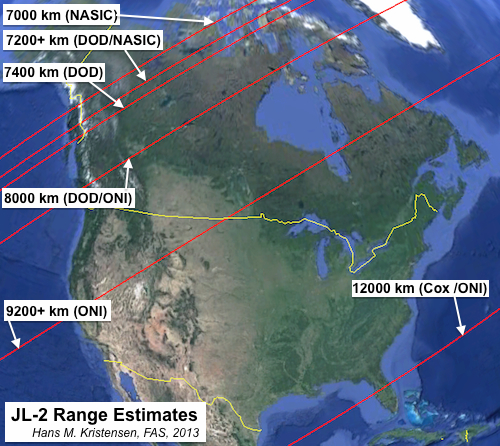
US range estimates for China’s Julang-2 SLBM vary considerably, but most are around 7,200+ km.
The latest range estimates of 7,000+ km (NASIC) to 7,400+ km (DOD) show continued uncertainty within the U.S. Intelligence Community about the JL-2 capability. But both estimates also reaffirm that the missile cannot be used to target the continental United States from Chinese waters. Doing so would require a range of at least 8,400 km – and that would only reach Seattle. To target Washington DC from Chinese waters, the range would have to be at least 11,000 km. With the current range estimate of about 7,200+ km, a JL-2 equipped SSBN would have to sail deep into the Sea of Japan between the island of Hokkaido and Russia’s Primorsky Krai oblast to target Seattle, or venture far into the Pacific northeast of Tokyo. To target Washington DC, the SSBN would have to sail even further and launch from a position between the Aleutian Islands and Hawaii – more than halfway across the Pacific Ocean. Due to the apparent noise level of Chinese missile submarines and the extensive anti-submarine capabilities of the United States, that would indeed be risky sailing in a war.
Sending SSBNs far into dangerous water would be China’s only option to fire missiles directly at the United States if Chinese leaders wanted to avoid shooting across Russian territory (all China’s ICBMs launched at the United States from their current deployment areas would overfly Russia).
A JL-2 equipped SSBN could of course target U.S. territories outside the continental United States, including Alaska and Guam, from Chinese waters. To target Hawaii, and SSBN would have to launch from a position in the Sea of Japan or the Philippine Sea.
All of that just to say that JL-2 – despite what you might hear on the Internet – can not be used to target the continental United States. Instead, it is a regional weapon capable of targeting Alaska, Guam, India and Russia from Chinese waters.
So far three Jin-class SSBNs have been delivered and one or two more are in various stages of construction. By 2020, according to information obtained from ONI, China might operate 4-5 SSBNs (see image below). Now that China has said something about its submarines (see sections below), it would help if it would also say something in its next transparency initiative about how many SSBNs it plans to build. The United States, Russia, France and Britain have all shown their plans and there’s no reasons China cannot do so as well.
A Washington Times article recently described how many of China’s state-run press outlets have reported that China’s SSBNs “are now on routine strategic patrol,” and quoted the an article concluding that this “means that China for the first time has acquired the strategic deterrence and second strike capability against the United States.”
The first claim – that China’s SSBNs are now on routine strategic patrol – is wrong. Although it has operated an SSBN (the Xia) since the early 1980s, China has never conducted an SSBN deterrent patrol. And since the JL-2 is not yet operational, the SSBNs are certainly not on patrol yet. But even once the JL-2 becomes operational, it is not clear whether China will operate the SSBN fleet in the way other nuclear weapons states operate their SSBNs. For one thing, it seems unlikely that the Chinese leadership would authorize deployment of nuclear weapons onboard SSBNs unless in a crisis situation.
The second claim – that China for the first time has acquired the strategic deterrence and second-strike capability against the United States – is also not correct. China has had a nuclear deterrent and second-strike capability against the continental United States since 1981 when the silo-based DF-5 ICBM became operational. In 2008, that posture of 20 missiles was broadened with the addition of the road-mobile DF-31A ICBM. Even before the JL-2 has become operational, China already has about 40 ICBMs that can target the U.S. mainland.
Once the Jin/JL-2 weapon system becomes operational, China would theoretically be able to conduct SSBN deterrent patrols. But that will not in itself provide a submarine-based strike capability against the continental United States from Chinese waters because of the range limitations described above.
The So-Called Targeting Map
Chinese news media carried several stories (see for example here, here, here) in September about increasing transparency of the submarine force. Despite claims about “revelations,” the articles did not reveal much that wasn’t already known. That said, any official news about the secretive submarine force and its operations is of course better than nothing – and perhaps a new beginning.
What created the most attention in the United States, however, was a map (see figure below) that allegedly showed radioactive fallout over the western part of the country apparently following a Chinese submarine attack with the future JL-2 SLBM. I have not been able to find the original article with the map on Global Times but there were plenty of dramatic spin-offs in U.S. papers suggesting the image showed Chinese plans for a strike on the United States. And some hinted that publication in “state-run media” somehow reflected Chinese government endorsement of the information.

A map on a Chinese web site describes fictive fallout from hypothetical Chinese nuclear strike on the United States.
Instead, the map appears on huanqiu.com, a glossy military-techno web site without official government status. And the publication is not an “article” but a series of 30 slides with text below each image by someone who appears to have vacuum-cleaned the much of the information from the Internet – including from some of my publications. Statements made in other news articles by “military experts” Du Wenlong (identified as a senior researcher with the PLA Academy of Military Scientists) and Li Jie (affiliation not identified) do not appear in the slides. The Google translator lists the slides editor’s name as [Shen Then] and the artist that drew the map is identified as Pei Shen.
In other words, this map does not appear to be an official government product and does not appear to reflect official Chinese nuclear strike planning.
The map shows three colored regions of radioactive fallout progressively spreading across the United States after 3, 7, and 30 days. One city (Seattle) is identified and 20 other black dots appear to mark locations of major cities. Many are misplaced – and some are odd.
The radioactive fallout patterns on the map are also not very good and appear to be fictive. In reality, radioactive fallout patters are much more narrow, depending on wind and precipitation. In 2006, FAS and NRDC published a report in which we used advanced computer programs to simulate hypothetical Chinese nuclear strikes on the United States. They showed not surprisingly that use of only 20 missiles against American cities would kill tens of millions of people. Back then China only had about 20 DF-5A missiles that could reach the continental United States. But their 20 4-Megaton warheads would cause enormous devastation and extensive radioactive fallout throughout much of the United States (see figure below).
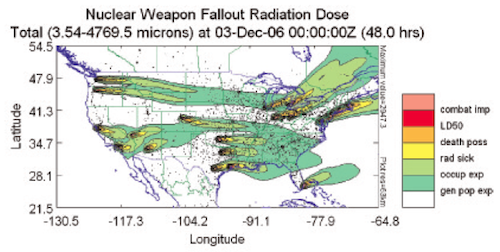
Fallout from attack on 20 US cities with 20 DF-5A 4-MT ground burst warheads.
Source: Hans M. Kristensen, et al., Chinese Nuclear Forces and U.S. Nuclear War Planning, FAS/NRDC, November 2006, p. 191.
Since then, China has introduced the DF-31A ICBM, each of which carries a smaller (but still significant) warhead. The second simulation we did therefore examined the effect of 20 DF-31A missiles, each with a 250-kiloton warhead. These explosions would also kill tens of millions of people but cause considerably less radioactive fallout (see figure below).

Fallout from attack on 20 US cities with 20 DF-31A 250-kiloton ground burst warheads.
Source: Hans M. Kristensen, et al., Chinese Nuclear Forces and U.S. Nuclear War Planning, FAS/NRDC, November 2006, p. 193.
* I’m indebted to Marius Bulla, a 21-year old GIS enthusiast and freelance photographer in Germany, for first bringing my attention to the Apple Maps image of the Jianhui upgrade.
Additional information: Chinese Nuclear Forces, 2013
This publication was made possible by grants from the New-Land Foundation and Ploughshares Fund. The statements made and views expressed are solely the responsibility of the author.
Capabilities of B61-12 Nuclear Bomb Increase Further
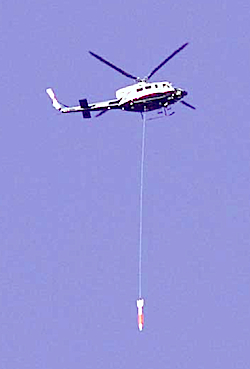
A B61-12 radar test drop conducted earlier this year.
By Hans M. Kristensen
With every official statement about the B61 nuclear bomb life-extension program, the capabilities of the new version (B61-12) appear to be increasing.
Previously, officials from the DOD, STRATCOM, and NNSA said the program is a consolidation of the B61-3, B61-4, B61-7, and B61-10 gravity bombs that would provide no additional military capabilities beyond those weapons.
This pledge echoed the 2010 Nuclear Posture Review, which states: “Life Extension Programs (LEPs)…will not support new military missions or provide for new military capabilities.”
Yet the addition of a guided tail kit will increase the accuracy of the B61-12 compared with the other weapons and provide new warfighting capabilities. The tail kit is necessary, officials say, for the 50-kilotons B61-12 (with a reused B61-4 warhead) to be able to hold at risk the same targets as the 360-kilotons B61-7 warhead. But in Europe, where the B61-7 has never been deployed, the guided tail kit will be a significant boost of the military capabilities – an improvement that doesn’t fit the promise of reducing the role of nuclear weapons.
More recently we also learned that the guided tail kit will provide the B61-12 with a “modest standoff capability,” something the current B61 versions don’t have.
And during yesterday’s hearing in the House Armed Services Committee’s Subcommittee on Strategic Forces, defense officials said the B61-12 would also replace the B61-11, a single-yield 400-kiloton nuclear earth-penetrating bomb introduced in 1997, and the B83-1, a strategic bomb with variable yields up to 1,200 kilotons.
If so, the military capabilities of the B61-12 will be able to cover the entire range of military targeting missions for gravity bombs, ranging from the lowest yield of the B61-4 (0.3 kilotons) to the 1,200-kiloton B83-1 as well as the nuclear earth-penetration mission of the B61-11.
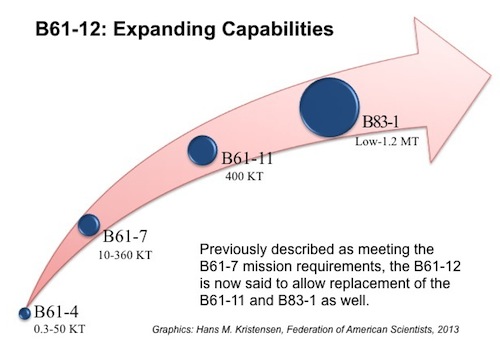
That’s quite an achievement for a weapon that just a few years ago was described simply as a refurbishment of four old B61s. Now the B61-12 has become the all-in-one nuclear bomb on steroids, spanning the full spectrum of gravity bomb missions anywhere.
That has some pretty significant implications in Europe where the United States has never deployed bombs with the military capabilities of the B61-7, B61-11 and B83-1. And it opens up a portfolio of enhanced targeting options with less radioactive fallout – more useable nuclear strike scenarios. Not bad for a simple life-extension, but less clear why it is needed and how it fits U.S. and NATO promises to reduce the role of nuclear weapons and seek “bold reductions” in U.S. and Russian nuclear weapons in Europe.
The Magic Reduction Bomb
During yesterday’s hearing, the military and nuclear lab officials portrayed the B61-12 as key to future reductions and modifications of the nuclear stockpile.
Since its inception, the B61-12 program has been described as a “consolidation” of four existing B61s into one allowing retirement of tree types. Now, in a blunt example of nuclear horse-trading in the 11th hour, the military and labs are adding retirement of the B61-11 and B83 as additional sweeteners to justify the expensive B61-12 program.
Without the B61-12, so the argument goes, the United States would not be able to reduce its inventory of gravity bombs. In contrast, completion of the B61-12 program “will result in a reduction in the total number of nuclear gravity bombs in our stockpile by a factor of two,” according to NNSA.
That is a stretch, to say the least. In reality, nearly two-thirds of the gravity bombs currently in the stockpile are already inactive and would likely be retired anyway (see table).
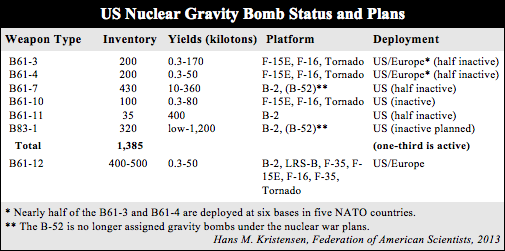
Yesterday, the officials ridiculed the B83 as a nuclear dinosaur with too big a yield (1.2 Megatons) even though they admitted that it also has lower yields. But that has been the case for decades and the B83 role faded years ago. After Congress rejected using the B83 warhead for the Robust Nuclear Earth Penetrator (RNEP), the B83 was decertified from first the B-1 bomber and more recently the B-52 bomber as well. That leaves the B-2 as the sole carrier with many more B83s in the stockpile than needed. The same goes for the B61-7.
Conclusions and Recommendations
Despite serious questions raised about the scope, cost, and management of the B61-12 and many other nuclear modernization programs, the Pentagon and NNSA yesterday portrayed the B61-12 – as well as the yet unclear but highly risky 3+2 warhead plan for the entire stockpile – as the cheapest solution to all nuclear issues: deterrence, assurance, modernization, and reductions. If that doesn’t set off alarm bells, I don’t know what would.
The hearing reminded me of the hearing a few years back were the CEOs of the tobacco industry were asked if nicotine were addictive; under oath they all said “no.”
Similarly, when asked yesterday if they could see any reason why the United States should not continue with the planned B61 life-extension program, the nuclear officials all said “no.”
To me, the willingness to trade all gravity bombs for the B61-12 is a tacit admission that most of the existing weapons are not needed but offered as sweeteners to “sell” the expensive program to Congress and the public.
Except for Representatives Loretta Sanchez and John Garamendi, none of the members that had shown up for the hearing asked any critical or difficult questions. Instead they appeared to invite the views that they knew the witnesses had anyway. There were no independent witnesses at the hearing, which appeared to be intended as a pushback against efforts in the Senate to scale back the B61-12 program.
There are no targets for the B61-12 that cannot be held at risk with ballistic or cruise missiles. And it is unlikely that there are any nuclear bombs deployed in Europe a decade from now. Instead, a basic gravity bomb capability on the B-2 and next-generation bomber could be achieved with a simpler and cheaper non-nuclear life-extension of the B61 as proposed by Senator Dianne Feinstein.
This publication was made possible by grants from the New-Land Foundation and Ploughshares Fund. The statements made and views expressed are solely the responsibility of the author.
New START Data Shows Russia Reducing, US Increasing Nuclear Forces
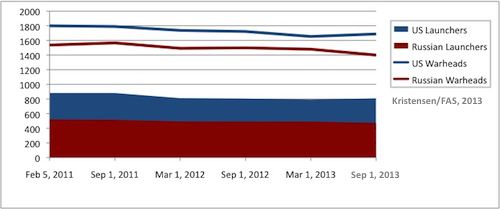
By Hans M. Kristensen
While arms control opponents in Congress have been busy criticizing the Obama administration’s proposal to reduce nuclear forces further, the latest data from the New START Treaty shows that Russia has reduced its deployed strategic nuclear forces while the United States has increased its force over the past six months.
Yes, you read that right. Over the past six months, the U.S. deployed strategic nuclear forces counted under the New START Treaty have increased by 34 warheads and 17 launchers.
It is the first time since the treaty entered into effect in February 2011 that the United States has been increasing its deployed forces during a six-month counting period.
We will have to wait a few months for the full aggregate data set to be declassified to see the details of what has happened. But it probably reflects fluctuations mainly in the number of missiles onboard ballistic missile submarines at the time of the count.
Slooow Implementation
The increase in counted deployed forces does not mean that the United States has begun to build up is nuclear forces; it’s an anomaly. But it helps illustrate how slow the U.S. implementation of the treaty has been so far.
Two and a half years into the New START Treaty, the United States has still not begun reducing its operational nuclear forces. Instead, it has worked on reducing so-called phantom weapons that have been retired from the nuclear mission but are still counted under the treaty.
For reasons that are unclear (but probably have to do with opposition in Congress), the administration has chosen to reduce its operational nuclear forces later rather than sooner. Not until 2015-2016 is the navy scheduled to reduce the number of missiles on its submarines. The air force still hasn’t been told where and when to reduce the ICBM force or which of its B-52 bombers will be denuclearized.
Moreover, even though the navy has already decided to reduce the missile tubes on its submarine force by more than 30 percent from 280 in 2016 to 192 on its next-generation ballistic missile submarine, it plans to continue to operate the larger force into the 2030s even though it is in excess of targeting and employment guidance.
Destabilizing Disparity
But even when the reductions finally get underway, the New START Treaty data illustrates an enduring problem: the growing disparity between U.S. and Russian strategic nuclear forces. The United States now is counted with 336 deployed nuclear launchers more than Russia.
Russia is already 227 deployed missiles and bombers below the 700 limit established by the treaty for 2018, and might well drop by another 40 by then to about 430 deployed strategic launchers. The United States plans to keep the full 700 launchers.
Put in another way: unless the United States significantly reduces its ICBM force beyond the 400 or so planned under the New START Treaty, and unless Russia significantly increases deployment of new missiles beyond what it is currently doing, the United States could end up having nearly as many launchers in the ICBM-leg of its Triad as Russia will have in its entire Triad.
Strange Bedfellows
For most people this might not matter much and even sound a little Cold War’ish. But for military planners who have to entertain potential worst-case threat scenarios, the growing missile-warhead disparity between the two countries is of increasing concern.
For the rest of us, it should be of concern too, because the disparity can complicate arms reductions and be used to justify retaining excessively large expensive nuclear force structures.
For the Russian military-industrial complex, the disparity is good for business. It helps them argue for budgets and missiles to keep up with the United States. But since Russia is retiring its old Soviet-era missiles and can’t build enough new missiles to keep some degree of parity with the United States, it instead maximizes the number of warheads it deploys on each new missile.
As a result, the Russian Strategic Rocket Forces has begun a program to deploy modified SS-27 ICBMs with multiple warheads (the modified SS-27 is known in Russia as RS-24 or Yars) with six missile divisions over the next decade and a half (more about that in a later blog). And a new “heavy” ICBM with up to ten warheads per missile is said to be under development.
So in a truly bizarre twist, U.S. lawmakers and others opposing additional nuclear reductions by the Obama administration could end up help providing the excuse for the very Russia nuclear modernization they warn against.
Granted, the Putin government may not be the easiest to deal with these days. But that only makes it more important to continue with initiatives that can take some of the wind out of the Russian military’s modernization plans. Slow implementation of the New START Treaty and retention of a large nuclear force structure certainly won’t help.
See also blog on previous New START data.
This publication was made possible by grants from the New-Land Foundation and Ploughshares Fund. The statements made and views expressed are solely the responsibility of the author.
B61-12 Nuclear Bomb Triggers Debate in the Netherlands

In a few years, US Air Force C-17 aircraft will begin airlifting new B61-12 nuclear bombs into six air bases in five NATO countries, including Volkel Air Base in the Netherlands (seen above).
By Hans M. Kristensen
The issue of the improved military capabilities of the new B61-12 nuclear bomb entered the Dutch debate today with a news story on KRO Brandpunt (video here) describing NATO’s approval in 2010 of the military characteristics of the weapon.
Dutch approval to introduce the enhanced bomb later this decade is controversial because the Dutch parliament wants the government to work for a withdrawal of nuclear weapons from the Netherlands and Europe. The Dutch government apparently supports a withdrawal.
Bram Stemerdink, who was Dutch defense minister in 1977 and deputy defense minister in 1973-1976 and 1981-1982, said that the Dutch government would have been consulted about the B61-12 capabilities. “Because we have those bombs at the moment. Was the Netherlands therefore consulted, yes,” Stemerdink reportedly said.
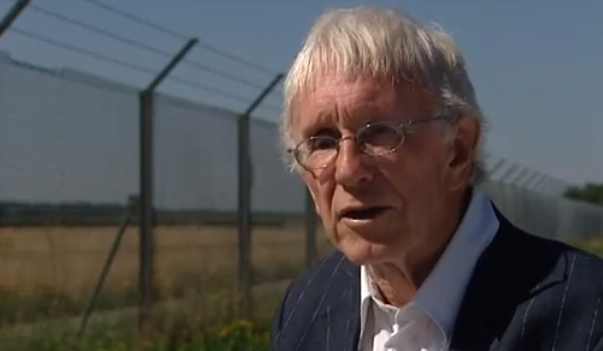
Former Dutch defense minister Bram Stemerdink said the Netherlands would have been consulted about the military capabilities of the enhanced B61-12 bomb.
NATO approved the military characteristics of the B61-12 in April 2010, according to the U.S. Government Accountability Office, “including the yield, that it be capable of freefall (rather than parachute-retarded) delivery, its accuracy requirements when used on modern aircraft and that it employ a guided tailkit section, and that it have both midair and ground detonation options.”
Dutch approval is also controversial because the improved military capabilities of the B61-12 compared with the weapons currently deployed in Europe (addition of a guidance tail kit to increase accuracy and provide a standoff capability) contradict the U.S. pledge from 2010 that nuclear weapon life-extension programs “will not…provide for new military capabilities.” The U.S. currently does not have a guided standoff nuclear bomb in its stockpile. The improved military capabilities also contradict NATO’s promise from 2012 to seek to “create the conditions and considering options for further reductions of non-strategic nuclear weapons assigned to NATO…”
Last month Dutch TV disclosed a dispute between the U.S. and Dutch governments over how to discuss potential financial compensation in case of an accident involving U.S. nuclear weapons in the Netherlands.
The B61-12 is currently being designed for production with a price tag of more than $10 billion for approximately 400 bombs – possibly the most expensive U.S. nuclear bomb ever.
Nuclear weapons are unlikely to remain in Europe for long, so instead of wasting more than $10 billion on the controversial enhanced B61-12 for a mission that has expired, the United States should instead do a more basic and cheaper life extension of an existing version. Instead of wasting money on modernizing a nuclear weapon for Europe, the United States should focus its efforts on changing the views of eastern European NATO countries by providing extended deterrence in a form that actually contributes to their security.
This publication was made possible by grants from the New-Land Foundation and Ploughshares Fund. The statements made and views expressed are solely the responsibility of the author.
Dispute Over US Nuke in the Netherlands: Who Pays For An Accident?
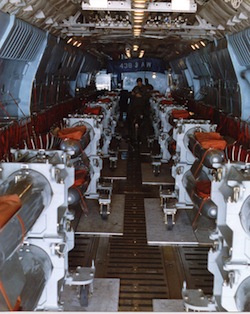
Who pays for a crash of a nuclear weapons airlift from Volkel Air Base?
By Hans M. Kristensen
Only a few years before U.S. nuclear bombs deployed at Volkel Air Base in the Netherlands are scheduled to be airlifted back to the United States and replaced with an improved bomb with greater accuracy, the U.S. and Dutch governments are in a dispute over how to deal with the environmental consequences of a potential accident.
The Dutch government wants environmental remediation to be discussed in the Netherlands United States Operational Group (NUSOG), a special bilateral group established in 2003 to discuss matters relating to the U.S. deployment of nuclear weapons in the Netherlands.
But the United States has refused, arguing that NUSOG is the wrong forum to discuss the issue and that environmental remediation is covered by the standard Status of Forces Agreement from 1951.
The disagreement at one point got so heated that a Dutch officials threatened that his government might have to consider reviewing US Air Force nuclear overflight rights of the Netherlands if the United States continue to block the issue from being discussed within the NUSOG.
The dispute was uncovered by the Brandpunt Reporter of the TV station KRO (see video and also this report), who discovered three secret documents previously released by WikiLeaks (document 1, document 2, and document 3).
The documents not only describe the Dutch government’s attempts to discuss – and U.S. efforts to block – the issue within NUSOG, but also confirm what is officially secret but everyone knows: that the United States stores nuclear weapons at Volkel Air Base.
Michael Gallagher, the U.S. Charge d’Affaires at the U.S. Embassy in Hague, informed the U.S. State Department that environmental remediation is “primarily an issue of financial liability” and discussing it “potentially a slippery slope.” During on e NUSOG meeting, Dutch civilian and military participants were visibly agitated about the U.S. refusal to discuss the issue, and Gallagher warned that “a policy of absolute non-engagement is untenable, and will negatively impact our bilateral relationship with a strong ally.”
Gallagher predicted that the Dutch would continue to raise the issue, and said the Netherlands was ahead of the other European countries that host U.S. nuclear weapons on their territories in having signed and implemented the NUSOG. Unlike Germany, Belgium, Italy and Turkey, the Netherlands was the only country that had raised the issue of remediation in a forum such as NUSOG, but Gallagher warned that the other countries would raise the issue of remediation in the future as similar nuclear weapons operational groups are established.

Charge d’Affaires Michael Gallagher shakes hands with Dutch foreign minister Frans Timmermans, who wants U.S. nuclear weapons removed from the Netherlands.
The United States has deployed nuclear weapons in the Netherlands since April 1960 and currently deploys an estimated 10-20 nuclear B61 bombs in underground vaults inside 11 aircraft shelters at Volkel Air Base. The weapons are under the custody of the US Air Force’s 703rd Munitions Support Squadron (MUNSS), a 140-personnel unit that secures and maintains the weapons at Volkel.
In a war, the U.S. nuclear bombs at Volkel would be handed over to the Dutch Air Force for delivery by Dutch F-16 fighter-bombers of the 1st Fighter Wing. The Netherlands is one of five non-nuclear NATO countries (Belgium, Germany, Italy, the Netherlands, and Turkey) that have this nuclear strike mission, which clearly violates the spirit of the nuclear Non-Proliferation Treaty.
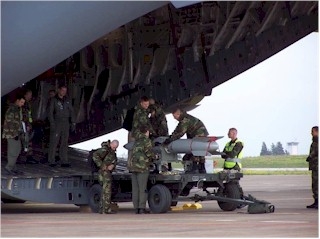
A B61 nuclear bomb is loaded onto a C-17 cargo plane. Improved B61-12 bombs are scheduled to be deployed to Volkel at the end of the decade.
From 2019 (although delays are expected), the U.S. Air Force would begin to deploy the new B61-12 nuclear bomb to Volkel and the five other bases in Europe that currently store the old B61 types. The B61-12, which is scheduled for production under a $10 billion-plus program, will have improved military capabilities compared with the weapons currently stored at the bases.
The U.S.-Dutch dispute over remediation is but the latest political irritant in the deployment of U.S. nuclear weapons in Europe, a deployment nearly 200 B61 bombs at five bases in six countries that costs about $100 million a year but with few benefits. President Obama has promised “bold reductions” in U.S. and Russian tactical nuclear weapons in Europe. Volkel Air Base would be a good place to start.
This publication was made possible by grants from the New-Land Foundation and Ploughshares Fund. The statements made and views expressed are solely the responsibility of the author.
MSNBC On Nuclear Weapons Reduction Efforts
By Hans M. Kristensen
MSNBC used FAS data on the world nuke arsenals in an interview with Ploughshares Fund president Joe Cirincione about how deteriorating US-Russian relations might affect efforts to reduce nuclear arsenals.
The updated weapons estimates on the FAS web site are here.
Detailed profiles of each nuclear weapon state are published as Nuclear Notebooks in the Bulletin of the Atomic Scientists.
Support our work to produce high-quality estimates of world nuclear forces: Donate here.
